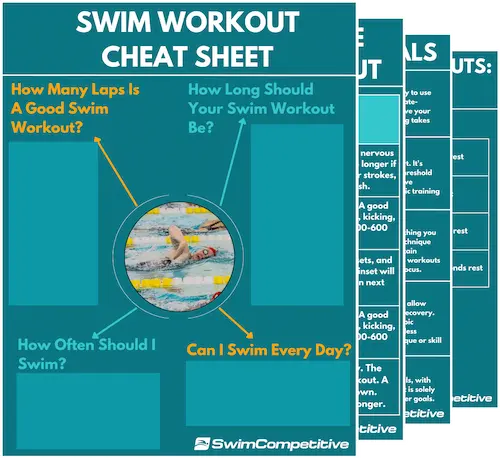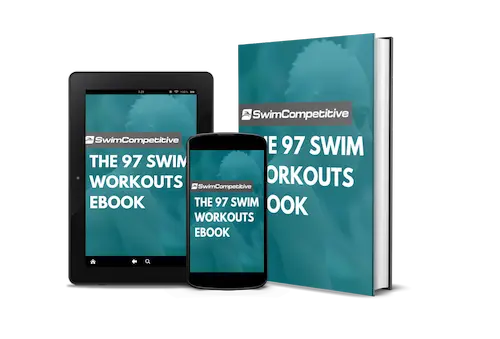Are you looking to hit the gym and lift some weights to enhance your swimming? Well, that’s a great idea! Weight lifting holds many benefits for swimmers and athletes in general and can help to enhance your swimming performances by providing you with an added base of strength, power, and muscle that will translate into faster swimming, better underwaters, dives, push-offs, and even a reduced risk of injury.
It is, however, important to have a good set of weight lifting guidelines that you can follow to not only ensure that you don’t get injured while lifting weights but also to make sure that you aren’t wasting your time on unnecessary exercises and practices that can harm your swimming and everything you’ve worked for up until this point.
That’s why in today’s article, we’ll be taking a look at 8 rock-solid weight lifting guidelines for swimmers that will ensure that your time in the weight room is worthwhile and that you’ll be making some good progress in the pool in the seasons to come without hurting yourself and creating setbacks.
Weight Lifting Guidelines for Swimmers
Here are 8 weight lifting guidelines every swimmer should follow-
- Always warm up properly before lifting weights.
- Learn the proper lifting technique for each exercise.
- Do static stretching after lifting weights to ensure you stay flexible.
- Do not lift until muscle failure.
- Allow time for adequate recovery between weight lifting workouts.
- Lift for speed and strength, not for aerobic capability.
- Focus on compound exercises over isolation exercises.
- Make sure that your nutrition supplements your weight lifting- and swimming training.
1. Always Warm Up Properly Before Lifting Weights
This might sound like a no-brainer, and sure, many swimmers and athletes are actually pretty consistent with warming up before every workout, but there’s a difference between just warming up for swimming practice and warming up to lift a heavy load that is inevitably going to put a lot of pressure on your body and internal nervous system.
Many swimmers may think that doing a couple of stretches and a bit of foam rolling is enough of a warm-up before hitting the iron. This is unfortunate, because it isn’t the case at all. And your chances of getting injured will be significantly higher.
When warming up to lift weights, I recommend spending no less than 10-15 minutes just on warmup. You should make sure to get the blood flowing thoroughly and to activate your muscles properly.
I recommend starting out with some foam rolling. Do 30-50 rolls on each muscle group, you can also say choose to roll out each muscle group for 30-60 seconds, spending less time on smaller muscle groups and more on bigger muscle groups.
Once you are done foam rolling you should do one or two dynamic stretches for each muscle group to just loosen them up and get some movement going. Note that I said dynamic stretches, not, static stretches.
Dynamic stretches refer to stretches that have active movement involved, while static stretches are stretches that place you in a fixed position and focus on flexibility.
After that I like to go through a series of resistance band warmup exercises, especially exercises that are going to open up the chest and activate the shoulder and back muscles such as band pull-a-parts, external shoulder rotations, and 90° shoulder rotations. It’s also important to do some lower-body warmup exercises. This can include resistance band squats and stability ball hip thrusts.
After that your body should be completely warm and activated and you’ll be good to lift some weights. It’s, however, important to also start off with a lower weight and then work your way up to the weight load you’d like to use for your sets, this will allow your body and nervous system time to adapt and will make your training feel easier while preventing injuries.
2. Learn Proper Weightlifting Technique
Before you can begin your weight training it’s important to make sure that you are performing each exercise with the right technique. If you don’t you’ll be prone to injury and you’ll also be limiting your results by restricting your range of motion and muscle activation during the exercise.
You can choose to hire a personal trainer for a couple of sessions until you’ve got the technique down or you can take some time, do proper research, watch videos, and practice the technique before starting to lift heavy.
I recommend starting out by learning the basic movement patterns of each exercise with a light PVC pipe and then progressing to the empty bar. Whereafter, you’ll start adding weight as you get stronger and stronger.
Please also note, I don’t recommend trying to learn Olympic Lifting technique and exercises since these are highly complicated. If you are looking to do that type of lifting you’d be best off going to a gym and getting trained by someone who is an expert in this field, such as a strength coach for example.
3. Do Static Stretching After Your Lifting Workouts for Flexibilty
Flexibility is a very important part of being a good swimmer. If you aren’t flexible you’ll be more likely to get injured, but you’ll most likely also be lacking in your range of motion and physical capability in the water due to you being tight and immobile.
Note that I’m not talking about temporary inflexibility, this is going to be inevitable when lifting weights since you’ll naturally be tight and sore from time to time which might, unfortunately, affect your swimming practices a bit here and there. I’m rather talking about a general lack of flexibility.
Luckily, you’ll actually be able to become more flexible when combining weight lifting and static stretching. By doing static stretching after your lifting workout when your body is still warm you will be able to increase your flexibility and range of motion, despite the common belief that weight lifting will reduce your mobility.
I recommend doing 2-3 static stretches for each muscle group and holding that stretch for at least 30 seconds before moving to the next. This shouldn’t take you more than 15 minutes.
Thus if we look at the bigger picture of things you’ll be able to get in a really solid workout that won’t only enhance your strength, but also your flexibility in about an hour and a half. (15 minutes warmup, 1-hour lift, 15 minutes static stretching).
4. Don’t Lift Until Muscle Failure
Lifting until failure is an old school weight lifting technique practiced by body-builders who were looking to build muscle, not enhance athletic performance. Unfortunately, this is still something commonly seen today.
As a swimmer, your main focus is going to be on getting stronger so that your swimming performance will benefit from that as a result, you’re not trying to build as much muscle mass as possible.
Lifting until failure will only make you sore and tired and will significantly hinder your performance in swimming practice and will make you much more prone to overtraining, which is unacceptable.
5. Allow Time for Adequate Recovery Between Lifting Workouts
Weight lifting is definitely going to place a lot of stress on your body due to the added resistance on muscles causing them to temporarily create micro-tears. It is thus important to make sure you get enough recovery between lifting workouts.
This won’t only ensure that you are able to come and lift with a good amount of energy every time, but it’ll also help you to go hard in swimming practice day in and day out without feeling overly tired and sore.
For the majority of swimmers, I recommend lifting 3 times a week. This is going to mean that you’ll be doing a full-body workout on Monday, Wednesday, and Friday with a rest day in between each.
If you feel that you don’t need that much you can even consider doing only 2 lifting workouts a week on say Monday, and Thursday. I, however, don’t recommend lifting less than 2 times a week or else you’ll just be wasting your time.
For more guidance on this topic check out my article on how to create a weight lifting program for swimmers.
Other ways you can speed up your recovery between workouts is by doing more stretching, foam rolling, eating healthy, sleeping enough, and maybe getting a sports massage or taking an ice bath when needed.
Do You Want to Make Every Lap Count?
Stop wasting your time in the pool feeling lost and doing directionless swim workouts, and start training effectively! Our ebook contains 97 structured and goal-orientated swim workouts to help you become a better, faster, and fitter swimmer. Whether you’re a complete beginner or a seasoned pro, there are a multitude of workouts for every type of swimmer.
6. Lift for Speed and Strength, Not for Aerobic Capability
As a swimmer, you are already doing an absolute ton of aerobic work in the pool on a daily basis. Thus it’s not at all necessary to lift weight for aerobic reasons. Remember, everyone has an anaerobic threshold and once you reach this threshold you’ll simply be wasting your time trying to make progress any faster.
When you are lifting weights you are doing it to develop strength, power, and speed. This means big lifts with lower reps and higher weight. Sure, there is a time and place for lower weight and higher reps if you’re looking to add some extra muscle, especially for the more skinny swimmers out there. Just be careful at what time of the season you decide to train this way.
7. Focus on Compound Exercises Over Isolation Exercises
Part of developing some solid strength and spending your time as efficiently as possible in the weight room is going to come down to the type of exercises you do. As a swimmer and athlete, you need to be focusing on compound exercises that target multiple large muscle groups, rather than isolating a single muscle group like bodybuilders like to do.
This is going to help you to get the most out of your workouts and will also develop total body strength and athletic performance which will translate into better swimming performance.
Some of my favorite compound strength exercises include:
- Pull-ups
- Bench press
- Overhead press
- Barbell Rows
- Back Squats
- Front Squats
- Deadlifts
- Romanian deadlifts
- Push-ups
- Dips
- Hip thrusts
- Leg press
8. Make Sure That Your Nutrition Supplements Your Weight Lifting- and Swimming
Another important part of getting the best results out of your training and making sure that your recovery is optimal is by eating healthy and eating enough. A training schedule consisting of multiple weight lifting and swimming sessions each week is very demanding and will require you to eat a lot of food to ensure optimal growth and recovery.
Make sure that you eat lots of carbs, proteins, and fats. This will make sure that your body is able to repair micro-tears caused by weight lifting as well as replenishing glucose levels during your workouts to fuel optimal performance.
When you start lifting weights you’ll have to place added emphasis on eating enough protein since this is ultimately going to fuel the muscle building and recovery process. I recommend eating about 0.6-0.8 grams of protein per pound of body weight.
Personally, I like to use a protein supplement to help me achieve this. You can check out my guide on supplements for swimmers if you’d like to learn more.
Improve Your Swimming with These Weight Lifting Guidelines
Weight lifting can be very beneficial for swimmers by enhancing speed, power, strength and athletic capability and also helping them to understand the importance of concepts like nutrition and recovery in their training, which can lead to further improvements in the long run.
It’s, however, important to follow these guidelines to ensure that swimmers are making proper progress in their weight training and not wasting their time by doing unnecessary exercises or creating injuries for themselves.






